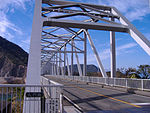
This list of continuous bridge spans ranks the world's continuous truss bridges in two listings: The first is ranked by the length of main span (the longest length of unsupported roadway) and the second by the total length of continuous truss spans.
Both lists include bridges that act primarily as a continuous truss. These bridges may appear to be—or may incorporate elements of—a different design. For example, the now destroyed Francis Scott Key Bridge incorporated an arch shape into the design, but was continuous across multiple spans. The Key Bridge acted first as a continuous truss bridge and secondarily as an arch bridge. This list does not include cantilever bridges.
Only bridges that are currently in use are included in the rankings. Bridges currently being planned, designed, or constructed and bridges that have been destroyed or demolished are noted separately.
List ranked by length of main span
[edit]The length of main span is the most common method of comparing the size of bridges. The length of the main span will often correlate with the depth of the truss (height the truss from bottom to top) and the engineering complexity involved in designing and constructing the bridge.
For bridges that have the same span length, the older bridge is listed first.
- Note: Click on each bridge's rank to go to the bridge's official Web site. Ranks with a red asterisk (*) do not have official Web sites (or they do not have an English-language version) and are linked instead to a reference entry.
List ranked by total length
[edit]It is also possible to rank continuous truss bridges by the sum of the continuous spans.
Note that if the bridge has an expansion joint (a discontinuity), the sections of the bridge would be considered separate (by the definition of a continuous bridge) for the purposes of this ranking. The Yoshima Bridge is an example of this. It consists of two continuous-truss sections that together have five total spans. The first section (or unit) is 2-span continuous, 125 m + 137 m; the second section is a 3-span unit, 165 m + 245 m + 165 m.[2]
| Rank | Name | Location | Individual span lengths in meters or feet |
Total length in meters (feet) | |
|---|---|---|---|---|---|
 |
1 | Pakokku Bridge | 390 ft | 6,278 m (20,597 ft) | |
| Thanlwin Bridge (Mawlamyine) | 367 ft | 6,596 m (21,640 ft) | |||
| Irrawaddy Bridge (Nyaungdon) | 390 ft | ||||

|
2 | Dashengguan Bridge | 108 + 192 + 336 + 336 + 192 + 108 meters [3] | 1,272 metres (4,173 ft) | |

|
2 | Jiujiang Yangtze River Bridge | 3*162 + 180 + 216 + 180 + 2*126 m[4] | 1,314 m (4,311 ft) | |

|
3 | Francis Scott Key Bridge (destroyed in 2024) | 219.6 + 366 + 219.6 meters [5] | 2,640 feet (800 m) | |

|
4 | Ikitsuki Bridge | 200 + 400 + 200 m[5] | 800.0 m (2,624.7 ft) | |

|
5 | Astoria-Megler Bridge | 616 + 1,232 + 616 ft[5] | 751 m (2,464 ft) |
History of the record span
[edit]| Name | Location | Main span in meters (feet) |
Longest from |
Longest to | |
|---|---|---|---|---|---|

|
Ikitsuki Bridge | 400 m (1,300 ft) | 1991 | present | |

|
Astoria-Megler Bridge | 375.6 m (1,232 ft) | 1966 | 1991 | |

|
Duisburg-Rheinhausen Bridge | 254.5 meters (835 ft) | 1945 | 1966 | |

|
Sciotoville Bridge | 236 meters (774 ft) | 1916 | 1945 |
References
[edit]- Durkee, Jackson, "World's Longest Bridge Spans", National Steel Bridge Alliance, May 24, 1999
- Garrison, Ervan G. (1998). A History of Engineering and Technology: Artful Methods. New York: CRC Press. p. 296. ISBN 0-8493-9810-X. Retrieved 2008-07-09.
Table 13.4 The leading continuous truss bridges
- Theroux, Stephane (2005-01-17). "Top Continuous Truss Bridges". Blackdog Media. Archived from the original on 2007-09-29. Retrieved 2008-07-10.
- Lewis, Scott (2016-01-05). "The World's Ten Longest Continuous Truss Bridges". New York: Engineering News-Record.
- Janberg, Nicolas, Truss bridges, Structurae.de (an extensive database of structures)
Footnotes
[edit]- ^ "Warm Springs Creek Bridge". HighestBridges.com.
- ^ Honshu-Shikoku Bridge Authority. "Yoshima Bridge". Archived from the original on 2008-02-14. Retrieved 2008-07-12.
- ^ "Dashengguan Bridge (Nanjing, 2010)".
- ^ (Chinese) 有关“九江长江大桥”的图片 Archived 2015-01-28 at the Wayback Machine
- ^ a b c Ewert, Sven (2003). Brücken (Bridges) (in German). Ernst & Sohn. p. 43. ISBN 3-433-01612-7. Retrieved 2008-07-11.
















